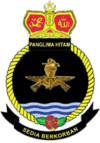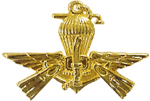PASKAL
The Pasukan Khas Laut (English: Naval Special Warfare Forces), commonly abbreviated PASKAL, is the principal special operations force of the Royal Malaysian Navy.
PASKAL's task is to conduct small-unit maritime military operations that originate from, and return to a river, ocean, swamp, delta or coastline. PASKAL also perform unconventional warfare; guerrilla warfare; jungle warfare; counter-terrorism; close protection; hostage rescue and foreign internal defence.
PASKAL and its army and air force counterparts, 11th Grup Gerak Khas Regiment and Flight Hostage Rescue Team of PASKAU, are the Malaysian military's primary counter-terrorism units.
Although PASKAL was created as a maritime counter-terrorism unit, it has become a multi-functional special operations unit with roles that include high-risk operations including direct action, special reconnaissance operations and other specialised missions.
PASKAL is an all-male force.
It was officially established on 1 October 1980, after a five-year setup period, with the purpose of enforcing Malaysia's Exclusive Economic Zone maritime claims through sea, air and land operations.
PASKAL personnel routinely serve in allied SOFs including the Indonesia Kopassus, Denjaka, Singapore Naval Diving Unit and Thailand Navy SEALs.
History
PASKAL had its origins in a perceived need for a security regiment trained in modern maritime operations. It main purpose was the protection of Malaysia naval bases and national assets. (At that time, the RMN main base was known as KD Malaya (Kapal Diraja Malaya, His Majesty's Ship Malaya), formerly known as HMS Malaya before independence, in Woodlands, Singapore, which was later transferred to the new naval base in Lumut, Perak when it was completed in 1979.)
The Security Regiment is largely composed of sailors responsible for the security of strategic sites such as bases and ammunition depots. When the main naval base at Lumut became available PASKAL headquarters was established there in 1981.
Initial training
Following the United Nations Convention on the Law of the Sea (UNCLOS) Malaysia was among the first nations to claim the right to extend maritime borders beyond the previous 12 (nautical) mile limit. The new unit received basic training at the Malaysian Army Grup Gerak Khas Special Warfare Training Center, Sungai Udang, Malacca.
In 1977, the first batch of 30 officers, led by Captain Sutarji Bin Kasmin (now Admiral, retired), was sent to Kota Pahlawan, Surabaya, Indonesia to receive jungle training delivered by Indonesian Navy KOPASKA.[2] On their return the cadre were referred to as Navy Commandos.
To enhance and diversify their skill set they trained in Portsmouth, United Kingdom with UK Royal Marines Commandos and to California by US Navy SEALs.[1] A few, including RMN senior officer, Lieutenant Commander Ahmad Ramli Kardi travelled on to Coronado, California and Norfolk, Virginia to receive additional training by the US Navy SEALs.
Exclusive Economic Zone
In April 1980, Malaysia declared that its EEZ reached up to 200 nautical miles from the coast as provided by the UNCLOS. This decision affected development plan as a naval fleet is directly responsible for controlling and protecting its national waters and has made Malaysia a maritime littoral nation of some 598,450 square kilometres (approximately 231060 square miles) including some four and a half thousand kilometres of coastline and over a thousand islands.
On 1 October 1982, PASKAL was officially established as the instrument used to enforce the Malaysian EEZ. In an effort to strengthen its claim over the Spratly Islands Waters (subject to overlapping claims by multiple countries) the National Security Council of Malaysia mandated PASKAL as Maritime Counter-Terrorism operatives in 1991.
Panglima Hitam
On 15 April 2009, PASKAL Team Command (PTC) was officially named KD Panglima Hitam in a ceremony held at the Royal Malaysian Navy HQ in Lumut, Perak by the King of Malaysia, Yang di-Pertuan Agong Tuanku Mizan Zainal Abidin to honour PASKAL's service.
KD Panglima Hitam translates into English as HMS Black Knight, inspired by His Majesty Sultan of Selangor, Sultan Sharafuddin Idris Shah Al Haj ibni Al Marhum Sultan Salahuddin Abdul Aziz Shah Al Haj as an honororary Navy Captain. A total of 34 names of sultans and 56 common names have been proposed to the RMN and were chosen: KD Panglima Hitam, KD Halilintar and the KD Maharaja Lela.
Panglima Hitam is a traditional title awarded to proven warriors during the era of the various Malay Sultanates in Perak, Selangor and Johore is a warrior skilled in fighting tactics. The symbolism of Panglima Hitam history and myth remains emblematic, representing strength, military prowess and strategic sense.[1][3]
Examples
Taiping, Perak
During his passage with his seven brothers in Makassar, Sulawesi, Daeng Kuning settled in Kuala Larut while his brothers continued to other destinations in the Malay Archipelago. Throughout his life he wore black clothes and was more skilled in self-defense than his siblings.
Kuala Selangor, Selangor
He was bodyguard to Sultan Ibrahim, the second Sultan of Selangor and Sultan Muhammad, the third Sultan of Selangor. His body was buried beside the tombs of the kings at Malawati Hill. Before his death, he was strictly enjoined that he was buried outside the royal tomb.
Jugra, Selangor
A bodyguard during the reign of the late Sultan Abdul Samad, the fourth Sultan of Selangor. By oral stories from the elders, his true name is Daeng Ali and his tomb is located at Royal Mausoleum in Jugra.
Muar, Johore
His true name is Baginda Zahiruddin and he is from Padang Pariaman Minangkabau, Sumatera Island, Indonesia. He is the founder of Silat Lintau in Indonesia and came to Malaya in the 16th centuries. He worked with local people to eradicate and eliminate the piracy in the estuary of Sungai Muar.
Segamat, Johore
He was the military leader responsible for defeating rebel groups during the Jementah War, which occurred in the area of Segamat. His tomb is located at Jementah in Segamat, Johor.
Roles and responsibilities
One PASKAL role is to launch offensive operations independently via sea, land and air in enemy-controlled waters. PASKAL operatives are trained to conduct maritime operations such as anti-piracy, ship and oil rig hijacking. (The security of more than thirty offshore oil rigs in Malaysian waters are PASKAL's responsibility. The unit holds regular training exercises on each rig.)
Other PASKAL roles include securing beachheads, deep penetration reconnaissance raids, structure and underwater demolition and sabotage. PASKAL also handles in-harbour underwater sabotage, ship-boarding assault, Counter-Terrorist missions (CT), infiltration behind enemy lines and mine-clearing.
Special joint training with army special units is conducted regularly on specialised skills like HALO and HAHO overwater and overland parachute jumps.[4]
PASKAL detachments are stationed on sensitive Malaysian offshore stations, particularly at Layang-Layang atoll while other detachments are permanently staged on RMN ships.[5]
Selection and training
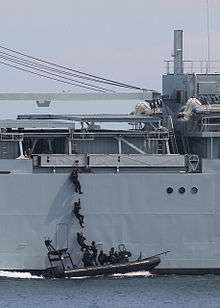
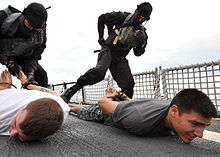
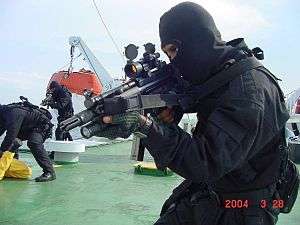
As a Special Forces unit, PASKAL's personnel are required to be mentally and physically agile. Every new trainee undergoes three months on the standard obstacle course at the RMN's Lumut Naval Base.
Applicants must be younger than 30 years old and of sound health. They must complete a basic commando course. Ssuccessful applicants attend the Special Warfare Training Centre (SWTC) in Sungai Udang, Malacca to undergo basic parachute training.
Next is the Advanced First Class training where they receive training in fields such as medic, communications, explosives and electrical–mechanical repair.
They must pass a physical test every three months.
Assignment to PASKAL is conditional on passing the PASKAL Physical Screening Test (PST). Prospective trainees are expected to exceed the minimums.
Among other activities the PST consists of:
- 7.8 km running in 24 minutes (below 24 years of age)
- 1.5 km swimming in not more than 25 minutes (in a swimming pool)
- 6.4 km swimming in open sea with full mission load – under 120 minutes
- Day–night skydiving at high elevation spots i.e. hills, buildings and on ocean surface
- Freestyle swimming for 1.5 km under 31 minutes
- Surviving in water with hands and feet fully tied up (drown-proofing)
- Diving without breathing apparatus for a minimum of 7 m in depth
Basic recruitment
- Pre-selection/warm-Up
- Basic PASKAL commando
- Diving endurance
- Basic sky-diving
Career development
- First class enrolment
- Underwater combat manoeuvre
- Leading Rate enrolment
- Petty Officer enrolment
- Diving/underwater combat superior
Members of PASKAL conduct training with Allied nation counter-terrorism units such as the Australian SAS, British SAS, US Navy SEALs, US Navy EOD, Australian Submarine Escape, Australian Clearance Diver, US Marine Corps Special Operations Training Group, etc.
On 26 August 1991, the National Security Council declared PASKAL as Malaysia's main counter-terrorist task for oil rigs and oil tanker security. It forms one of the elements in the Quick Reaction Force (QRF).
Expertise–Specialist Course
- Insertion techniques
- High-altitude military parachuting: Tactical, high altitude free-fall parachute insertion, employed in covert insertion into enemy territory
- Special Patrol Insertion/Extraction: Ability to rapidly insert and/or extract a reconnaissance patrol or assault team from enemy terrain; conduct SPIE rig of personnel from combat zone
- Combat technique
All PASKAL recruits receive special training and are operationally qualified to perform special operational duties. The training consists of:
- Combat Tracking: Direct action missions in jungle terrain, employing guerilla tactics, night combat and dynamic counter-insurgency techniques
- Pathfinding/Jungle Survival: Ability to handle insertion to set up and operate drop zones, pick-up zones and helicopter landing sites for airborne operations, air resupply operations, or other air operations in support of the ground unit commander. Survival skills to handle emergencies, especially in tropical forest and beachheads.
- Unarmed Combat: A mixture of Malay Silat and Korean Taekwondo martial arts as the main hand-to-hand combat techniques to take down the enemy at very close range.
- Close Quarters Combat Tactical: Tactical direct action missions, as well as visit, board, search and seizure (VBSS) operations or destruction of offshore gas, and oil platforms, employing close quarter battle combat and dynamic assault tactics and techniques.
- Sniper/counter-sniper tactics: Direct or counter sniper in urban warfare terrain, or reconnoitre jungle warfare, reduce the enemy's fighting ability by striking at high-value targets and pinning down and demoralising the enemy, as well as provide covering fire for Malaysian or designated friendly forces from enemy attacks, as well as enemy snipers.
- Explosive Ordnance Disposal: Ability to defuse or detonate explosive materials, such as time bombs, unexploded ordnance (UXO), naval mines, etc.
- Combat search and rescue: Conduct search and rescue during war or peacekeeping missions that are within or near combat zones.
- Military Operations on Urbanized Terrain: Conduct military operations in a built-up area.
- Combat Medic Specialist: Specialised medic for providing first aid and frontline trauma care.
- Foreign language: Use of foreign languages to communicate with allied forces, etc.
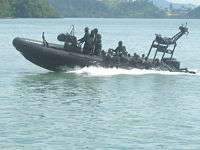
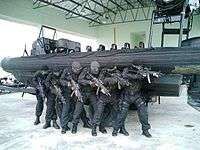
- Intelligence gathering
Besides combat and insertion skills, PASKAL units are able to gather intelligence to provide guidance to commanders in support of their decisions. Intelligence capabilities include:
- Counterintelligence: Tactical counter-intelligence to prevent hostile/enemy intelligence organisations from successfully gathering and collecting intelligence.
- Signals intelligence – SIGINT: Tactical SIGINT, limited ground based Electronic Warfare and communications security monitoring and analysis in direct support. This is accomplished by employing organic collection and direction finding equipment as well as through connectivity to national and theatre SIGINT/EW assets.
- C4-I (communications, command, control, co-ordination, intelligence) Systems Implementations: Tactical C4-I techniques to provide intelligence to command centre. The objective is a thorough understanding of mutual command and control procedures, capabilities, and limitations developed through continual participation in joint and combined exercises.
- Special reconnaissance: Reconnaissance behind enemy lines, avoiding direct combat and detection by the enemy.
- Long Range Reconnaissance Patrol: Use of four to six-man teams on reconnaissance and combat patrols, either obtaining intelligence, or performing raids and ambushes.
PASKAL tactics and organisation are heavily influenced by the British Special Boat Service (SBS) and the United States Naval Special Warfare Development Group (SEAL Team Six – DEVGRU). PASKAL usually trains with GGK as well as US Navy SEALs, Indonesian Navy KOPASKA and the SBS.[6]
Teams and structure
Naval Special Operations Units
The manpower details of this unit are highly classified. It is believed to be a regiment with an estimated 1,000 men divided into two operations units – PASKAL Unit Satu (PASKAL – First Unit) based in the Lumut Naval Amphibious Base in Perak on Peninsular Malaysia, and PASKAL Unit Dua (PASKAL – 2nd Unit) based at KD Sri Semporna, a Naval Amphibious Base in Semporna, Sabah. A company-strength (detachment) is based at Teluk Sepanggar Naval Base near Kota Kinabalu, Sabah.
Structure
PASKAL organises itself operationally into squadrons of at least four companies (or platoons) each. Each company is in turn organised roughly along the lines of the US Green Berets' structure of Alpha, Bravo, Charlie and Delta Detachments. The smallest PASKAL unit is the Boat Troop, with seven men. Each PASKAL company consists of:
- Alpha platoon
- The Versatile Special Operations Force, mainly trained for Maritime Counter-terrorism and other rescue operations into cargo vessels and oil rigs as well as urban terrain. This platoon is equipped with individual covering systems for close quarters combat.
- Bravo platoon
- An oxygen combat diving team and a special air operations team, both of which allow quiet infiltration of enemy territory. This squad is also trained to collect intelligence data to help the assault squad.
- Charlie platoon
- An auxiliary team with the role of strengthening special operations capacity from behind enemy lines.
- Delta platoon
- The conventional warfare team that dominated the amphibious warfare of PASKAL teams with special operation skills on the ground and sniping.
Each squadron contains a mixture of specialists that is adjusted for the specifics of the mission or area where it is tasked to operate. Each squadron normally carries a Combat Intelligence Team (Malay: Tim Risik Gempur, TRG), trained in maritime tactical intelligence, counter-intelligence and psychological operations.
Equipment
The weaponry and equipment inventory is a confidential subject. PASKAL teams use equipment designed for a variety of specialist situations including close quarters combat (CQC), urban warfare, hostile maritime interdiction (VBSS/GOPLATS), long range target interdiction, jungle warfare and special reconnaissance. Nevertheless, amid rumours of financing from the consortium of oil and shipping companies in addition to ample financing from the navy, PASKAL's inventory currently includes some of the world's most advanced and sophisticated equipment.
Voluntary contributions from the oil consortium and shipping companies ensured that PASKAL has sufficient means to procure specialised weapons and equipment including heavy body armour, ballistic shields, entry tools, tactical vehicles, advanced night vision optics, and motion detectors that are much more modern and sophisticated in comparison to the other special forces units in the Malaysian armed forces. All the weaponry and equipment was acquired under the Offensive Underwater Weapons program implemented under the 9th Malaysian Plans.
Uniforms
PASKAL personnel wear similar utility uniforms to the tactical uniforms worn by the military. Many armed forces diverged from the original standard black or blue uniforms, and PASKAL uniforms now include US Woodland camouflage patterns identical to that worn by SEALs.
Originally PASKAL units were equipped with balaclavas and M40 Field Protective Mask, or even PRO-TEC fiberglass baseball helmets. Modern PASKAL units commonly use the lightweight FAST helmets. Fire retardant balaclavas are often used to protect the face, as well as to protect the identity of team members. Ballistic vests, sometimes including rigid plate inserts, are standard issue.
Equipment
Night-vision devices
-
 USA: AN/PVS-7 night vision sight
USA: AN/PVS-7 night vision sight -
 USA: AN/PVS-14 night vision sight
USA: AN/PVS-14 night vision sight -
 USA: AN/PVS-21 night vision sight
USA: AN/PVS-21 night vision sight
Accessories
-
 USA: Advanced Combat Optical Gunsight (ACOG), recently renamed Rifle Combat Optic (RCO)
USA: Advanced Combat Optical Gunsight (ACOG), recently renamed Rifle Combat Optic (RCO) -
 Sweden: Aimpoint M68 Close Combat Optic (CCO) red dot reflex sight. US military designated of Aimpoint CompM2. Attached to family of MP5, MP7 and M4A1 rifles.
Sweden: Aimpoint M68 Close Combat Optic (CCO) red dot reflex sight. US military designated of Aimpoint CompM2. Attached to family of MP5, MP7 and M4A1 rifles. -
 Sweden: Aimpoint M68 Collimated Combat Optic - US Army's newest version of Aimpoint CompM4. Attached to HK416, G36, MP7, UMP45 and XM8
Sweden: Aimpoint M68 Collimated Combat Optic - US Army's newest version of Aimpoint CompM4. Attached to HK416, G36, MP7, UMP45 and XM8 -
 Switzerland: Brügger & Thomet suppressors - attached to HK416, G36, XM8
Switzerland: Brügger & Thomet suppressors - attached to HK416, G36, XM8 -
 Germany: Oerlikon Contraves LLM01 - attached to HK416
Germany: Oerlikon Contraves LLM01 - attached to HK416 - various tactical lights
Helmets
- lightweight FAST baseball caps
Thermal imaging common modules
Various ground tactical
- radar MASINT (Measurement and Signature Intelligence) - including PSR MASINT
Weaponry
PASKAL teams employ a variety of weapons, the most common weapons include shotguns, submachine guns, assault rifles, machineguns, sniper rifles and grenade launchers. Currently, they operate American and German-made weaponry, but in the Langkawi Airshow (LIMA 2015) maritime warfare, they used Heckler & Koch weapons, including the HK UMP45 submachinegun, HK416, G36 and a lightweight XM8 assault rifle. Pictures taken during national day parades including RMN anniversaries as well as LIMA and from local defence magazines indicate the use of the following:
Bladed weapons
Sidearms
-
 Austria: Glock 17 - Standard issue for RMN personnels, being supplemented with Glock 18C
Austria: Glock 17 - Standard issue for RMN personnels, being supplemented with Glock 18C -
 Germany: Heckler & Koch P9S - limited used by RMN personnels.
Germany: Heckler & Koch P9S - limited used by RMN personnels. -
 Germany: Heckler & Koch P11 underwater pistol.
Germany: Heckler & Koch P11 underwater pistol. -
 Germany: Heckler & Koch P30 - adopt for used by RMN personnels.
Germany: Heckler & Koch P30 - adopt for used by RMN personnels. -
 South Africa: Vektor SP1 - adopt limited used by PASKAL personnels.
South Africa: Vektor SP1 - adopt limited used by PASKAL personnels.
Shotguns
-
 United States: Remington 870 18.5mm Marine Magnums - as the M870 and Modular Combat Shotgun. Can be used in the close range combat or as a breaching gun. Being phased out in favour of the HK Fabarm FP6 shotgun.
United States: Remington 870 18.5mm Marine Magnums - as the M870 and Modular Combat Shotgun. Can be used in the close range combat or as a breaching gun. Being phased out in favour of the HK Fabarm FP6 shotgun. -
 United States: Remington 1100 18.5mm Tacticals - semi automatic 12-gauge shotgun.
United States: Remington 1100 18.5mm Tacticals - semi automatic 12-gauge shotgun. -
 Germany: Heckler & Koch FABARM FP6 - a 12-gauge pump-action combat shotgun, being issued as a replacement for the M870.
Germany: Heckler & Koch FABARM FP6 - a 12-gauge pump-action combat shotgun, being issued as a replacement for the M870.
Submachine guns
-
.svg.png) Belgium: FN P90[7] - A high power submachine gun used by PASKAL and is capable of penetrating the CRISAT vest at a range of 200 m (219 yd), or a Level IIIA Kevlar vest at the same range.
Belgium: FN P90[7] - A high power submachine gun used by PASKAL and is capable of penetrating the CRISAT vest at a range of 200 m (219 yd), or a Level IIIA Kevlar vest at the same range. -
 Germany: Heckler & Koch MP5 in all types and variants. A standard MP5 has been fitted with an RM Equipment M203PI grenade launcher.
Germany: Heckler & Koch MP5 in all types and variants. A standard MP5 has been fitted with an RM Equipment M203PI grenade launcher. -
 Germany: Heckler & Koch MP7 - A personal defence weapon (PDW) known to be used by PASKAL operators when missions require a very compact and potent weapon, especially for close protection.
Germany: Heckler & Koch MP7 - A personal defence weapon (PDW) known to be used by PASKAL operators when missions require a very compact and potent weapon, especially for close protection. -
 Germany: Heckler & Koch UMP .45 ACP
Germany: Heckler & Koch UMP .45 ACP
Assault rifles and carbines
-
 United States: Colt M16A1 (with 20-rounds Colt-manufactured STANAG magazines, 100-rounds Beta C-Mag drum magazines) - Former primary arm of PASKAL, replaced by the M4A1, HK416, G36 and others. Still in use with other PASKAL teams as well as some support personnel and ceremonial use only.
United States: Colt M16A1 (with 20-rounds Colt-manufactured STANAG magazines, 100-rounds Beta C-Mag drum magazines) - Former primary arm of PASKAL, replaced by the M4A1, HK416, G36 and others. Still in use with other PASKAL teams as well as some support personnel and ceremonial use only. -
 United States: Colt M4A1 Carbines - Carbine-length variant of the M16A2 with collapsible stock as the Malaysian Armed Forces standard rifle, fitted with Special Operations Peculiar Modification (SOPMOD) Block I kit.
United States: Colt M4A1 Carbines - Carbine-length variant of the M16A2 with collapsible stock as the Malaysian Armed Forces standard rifle, fitted with Special Operations Peculiar Modification (SOPMOD) Block I kit. -
 Germany: Heckler & Koch G36 - G36C, G36E and G36KE carbines in use.
Germany: Heckler & Koch G36 - G36C, G36E and G36KE carbines in use. -
 Germany: Heckler & Koch HK416[8][9][10] The primary rifle used by PASKAL, attached with Aimpoint CompM4S, Brügger & Thomet suppressor and Oerlikon Contraves LLM01 Laser Light Module.
Germany: Heckler & Koch HK416[8][9][10] The primary rifle used by PASKAL, attached with Aimpoint CompM4S, Brügger & Thomet suppressor and Oerlikon Contraves LLM01 Laser Light Module. -
 Germany: Heckler & Koch XM8 - A former military projects of the United States based on the G36 was hand over to PASKAL to reduce the over-reliance on the M4A1 rifles.
Germany: Heckler & Koch XM8 - A former military projects of the United States based on the G36 was hand over to PASKAL to reduce the over-reliance on the M4A1 rifles.
Anti-materiel rifles
-
 United Kingdom: Accuracy International AW50 – anti-materiel bolt-action rifle chambered in .50 BMG (12.7×99mm NATO).
United Kingdom: Accuracy International AW50 – anti-materiel bolt-action rifle chambered in .50 BMG (12.7×99mm NATO). -
 United States: Armalite AR-50
United States: Armalite AR-50 -
 Germany: DSR-Precision GmbH DSR-50
Germany: DSR-Precision GmbH DSR-50 -
 United States: Robar RC-50 – in use as response to requirements issued for an anti-materiel rifle.
United States: Robar RC-50 – in use as response to requirements issued for an anti-materiel rifle.
Designated marksman rifles
-
 Germany: Heckler & Koch HK417 - Improved marksman version of the HK416 rifle.
Germany: Heckler & Koch HK417 - Improved marksman version of the HK416 rifle. -
 Germany: Heckler & Koch MSG-90 - MSG90A1 variant in use
Germany: Heckler & Koch MSG-90 - MSG90A1 variant in use
Sniper rifles
-
 United Kingdom: Accuracy International Arctic Warfare
United Kingdom: Accuracy International Arctic Warfare -
 Germany: DSR-Precision GmbH DSR-1 - .308 Winchester subsonic bullpup sniper rifles.
Germany: DSR-Precision GmbH DSR-1 - .308 Winchester subsonic bullpup sniper rifles. -
 United States: M14 rifle - in use as sniper rifles. Select fire capability is retained.
United States: M14 rifle - in use as sniper rifles. Select fire capability is retained. -
 United States: M40 rifle - in use as sniper rifles.
United States: M40 rifle - in use as sniper rifles.
Machine guns
-
 Spain: CETME Ameli
Spain: CETME Ameli -
.svg.png) Belgium: FN Minimi - 5.56×45mm light machine gun, being phased out in favour of the HK MG4.
Belgium: FN Minimi - 5.56×45mm light machine gun, being phased out in favour of the HK MG4. -
 Germany: Heckler & Koch MG4 - 5.56mm belt-fedmachine gun, being issued as a replacement for the Minimi.
Germany: Heckler & Koch MG4 - 5.56mm belt-fedmachine gun, being issued as a replacement for the Minimi. -
.svg.png) Belgium: FN MAG - 7.62×51mm medium machine gun used primarily on vessels and helicopters.
Belgium: FN MAG - 7.62×51mm medium machine gun used primarily on vessels and helicopters. -
 South Africa: Vektor SS-77 GPMG - 7.62×51mm medium machine gun used primarily on lighter vessels and helicopters.
South Africa: Vektor SS-77 GPMG - 7.62×51mm medium machine gun used primarily on lighter vessels and helicopters.
- Note: All H&K weapons operated by PASKAL on the first time during Operation Daulat.
Hand grenades
-
 United States: M67 Hand Grenade (Fragmentation)
United States: M67 Hand Grenade (Fragmentation) -
 United States: AN-M14 Hand Grenade (Incendiary)
United States: AN-M14 Hand Grenade (Incendiary) -
 United States: Mk 141 Mod 0 Hand Grenade "flash-bang"
United States: Mk 141 Mod 0 Hand Grenade "flash-bang" -
 United States: AN-M18 Smoke grenade
United States: AN-M18 Smoke grenade
Grenade launchers
-
 United States: M203A1/A2 40 mm Rifle-Mounted Grenade Launcher
United States: M203A1/A2 40 mm Rifle-Mounted Grenade Launcher -
 Germany: Heckler & Koch AG36 – a single-shot 40mm underbarrel grenade launcher, fitted with HK416, G36 and XM8 rifles.
Germany: Heckler & Koch AG36 – a single-shot 40mm underbarrel grenade launcher, fitted with HK416, G36 and XM8 rifles. -
 Germany: Heckler & Koch GMG 40 mm Automatic Grenade Launcher
Germany: Heckler & Koch GMG 40 mm Automatic Grenade Launcher -
 Germany: Heckler & Koch M320 40 mm Grenade Launcher Module
Germany: Heckler & Koch M320 40 mm Grenade Launcher Module
Others
-
 United States: M18A1 Claymore anti-personnel mine
United States: M18A1 Claymore anti-personnel mine -
 Malaysia: Sutarji Underwater Gun - a grappling hook launcher specialised to catch ship rigging so that it could be boarded.
Malaysia: Sutarji Underwater Gun - a grappling hook launcher specialised to catch ship rigging so that it could be boarded.
Vehicles
PASKAL utilises specialised delivery craft – among others, PASKAL employs high speed inflatable/collapsible subskimmers (also known as UDV – Underwater Delivery Vehicle), for infiltrations into hostile areas.
The acquisition of two Scorpène submarines which are jointly being built by DCNS, France and Navantia, Spain ("KD Tunku Abdul Rahman" commissioning January 2009, "KD Tun Razak" commissioning October 2008) is expected to further add PASKAL's capabilities and range.[11]
Emblems and badges
.jpg)
- Reddish Purple (Magenta) coloured beret
- The magenta beret reflects PASKAL's identity and its close relationship with the Indonesian Marine Corps.
- Navy blue lanyard
- The navy blue lanyard reflects the Royal Malaysian Navy and possibly reflects their founding trainers, the British Royal Marines Commando.
- Camouflage
- The PASKAL camouflage uniform is identical to that worn by US Navy SEALs. It reflects the close relationship with this US Special Forces unit from which PASKAL receives training.
- Trimedia
- The "Trimedia" is PASKAL's main emblem which is worn by every PASKAL trooper. The various components symbolises:
- Wing – the traditional symbol for airborne capability
- Jet Fin & Face Mask Emblem – symbolises seaborne infiltration capability
- Combat Dagger – symbolises jungle-warfare capability
- Anchor – the symbol for the Royal Malaysian Navy (RMN).
Commanding officers
| Name | Year | Remark |
|---|---|---|
| First Admiral Assoc. Prof. Dr. Haji Sutarji bin Kasmin | 1975–2003 | PASKAL Commander from 1975 and retired in 2003 |
| Vice Admiral Dato' Haji Nasaruddin bin Othman | 2003 - 2015 | |
| First Admiral Dato' Saifudin Bin Kamarudin | - present |
Notable PASKAL members
- First Admiral Assoc. Prof. Dr. Haji Mohd Sutarji Bin Kasmin (retired) — first commanding officer of PASKAL, considered godfather of PASKAL
- Vice Admiral Dato' Haji Nasaruddin Bin Othman (retired) — second commanding officer of PASKAL, replacing First Admiral Dr. Haji Sutarji Kasmin
- First Admiral Dato' Saifudin Bin Kamarudin
- Captain Jamaludin Bin Mohd Saman RMN
- Commander Abd Malek Bin Hj Mohd Daud RMN
- Commander 806879 Ahmad Ramli Bin Kardi — honoured Ahli Mangku Negara, Ahli Mahkota Perak medal
- Commander Anuar Bin Alias — honoured Panglima Gagah Berani medal
- Commander George Paul Thomas Rozario
- Lieutenant Commander Che Adnan Bin Mat Isa
- Lieutenant Commander Samrus Bin Che Dan (died 18 June 2012)
- Master Chief Petty Officer Mohd Room Bin Bahari
- Seaman Hairi Mat Balong
- Ordinary Seaman Sukeri Bin Abdullah (1994–1997)
- Chief Petty Officer 814726 Mohd Idros bin Mohd Yusof
Operations and covert actions
The unit has been deployed in the following operations:
| Operation | Roles | Country | Year |
|---|---|---|---|
| Spratly Islands | Security Mission | | 1980s |
| Gugusan Semarang Peninjau | Security Missions | | 1979 |
| United Nations Operation in Somalia II (UNOSOM II) | Peacekeeping Missions | | 1993–1995 |
| United Nations Angola Verification Mission II (UNIVEM II) | Peacekeeping Missions | | 1998 |
| Operation Astute | Peacekeeping Missions | | 2006 |
| United Nations Interim Force in Lebanon (MALCON-UNIFIL) | Peacekeeping Missions | | 2007 |
| United Nations Interim Force in Lebanon II (MALCON-UNIFIL II) | Peacekeeping Missions | | 2008 – present |
| Operation Dawn | Hostage Rescue | | 2008 – present |
| International Security Assistance Force (MALCON-ISAF) | Humanitarian aid | | 2010 – present |
Operation Dawn (Ops Fajar)
PASKAL operatives were deployed subsequent to the hijacking by Somali pirates of two Malaysian merchant vessels, MISC-owned Bunga Melati 2 and Bunga Melati 5. The PASKAL detachment was tasked to intelligence-gathering and also to provide security to the Malaysian team negotiating the release of both ships and their crew. This operation, codenamed Ops Fajar (Operation Dawn) also involved Royal Malaysian Navy assets comprising KD Lekiu, KD Sri Inderapura, as well as supported elements of Malaysian Army special forces, Grup Gerak Khas as well as some RMAF assets.[12]
Rescue operations of Zhenhua 4
18 December 2008 – The Royal Malaysian Navy rescued a Chinese-registered ship, Zhenhua 4 in the Gulf of Aden on Wednesday, the same day the United Nations Security Council decided to be more assertive against the Somali pirates. The Zhenhua 4 was attacked by nine armed pirates about noon on Wednesday while on its way from Djibouti to China.
Called on by the Combined Task Force 150 (CTF-150), the multinational coalition patrolling the pirate-infested gulf, the RMN's KD Sri Indera Sakti despatched a helicopter (including PASKAL naval commando) to the scene. The helicopter fired two warning shots at the pirates' skiff, causing them to call off the attack on the heavy load carrier Zhenhua 4 and flee.[13][14]
Rescue operation of MV Abul Kalam Azad
1 January 2009 – PASKAL operatives together with RMN KD Sri Inderasakti, commanding by Captain Mohamad Adib Abdul Samad experienced its first combat in the new year when its Fennec helicopter drove off two pirate skiffs pursuing Indian-registered crude oil tanker MT Abul Kalam Azad in the Gulf of Aden. The 92,000-tonne vessel, with 40 crew members, was heading for the Suez Canal with a full load of crude oil, sailing in the gulf at 11.37am (Malaysian time) when it was attacked by pirates in two skifs. One of the boats had seven men in it, all armed with AK-47s and machineguns. They unleashed a barrage of fire at the bridge and accommodation area of the ship. They also tried to board it, all the while keeping up the attack.
However, the ship began taking evasive measures and increased speed to the maximum. This was also when it issued a distress signal, which was picked up by Malaysian navy support ship KD Sri Indera Sakti about 15 nautical miles away. In rapid response, Captain Mohamad Adib dispatched the ship-borne Fennec helicopter gunship armed with twin general purpose machine guns and an elite Naval Special Forces PASKAL airborne sniper. The Malaysian helicopter was joined by a Eurocopter AS 365 Dauphin helicopter of the Royal Saudi Navy, effectively scaring off the pirates.
The captain of the Abul Kalam Azad had initially requested to join the Malaysian International Shipping Corporation convoy, escorted by the Sri Indera Sakti, but later accepted the offer from a Saudi Arabian naval ship to escort it to its destination. International Maritime Bureau Piracy Reporting Centre head Noel Choong said the crew of the Abul Kalam Azad reported seeing the pirates in military-style garb.[15][16]
MALCON – ISAF
The special forces included PASKAL, Grup Gerak Khas, PASKAU and 10 Paratrooper Brigade was deployed with other Malaysian contingent to involve the administrative workload at the International Security Assistance Force (ISAF) in Afghanistan. The team was deployed to assist the New Zealand Armed Forces in the peacekeeping missions and humanitarian aid at the Bamiyan District, Afghanistan.[17]
Operation Dawn 8: Gulf of Aden
20 January 2011 – PASKAL maritime counter-terrorism assault teams successfully thwarted an attempted hijacking by Somali pirates on the Malaysian chemical tanker, a MT Bunga Laurel in the Gulf of Aden. The tanker, laden with lubricating oil and ethylene dichloride that was headed for Singapore in the nick of time was attacked by the mothership with 18 armed pirates about 300 nautical miles (555 km) east of Oman at 11.40pm. Under the cover of darkness, seven pirates armed with AK-47 assault rifles, light machine guns and pistols suddenly emerged from a skiff boat and began boarding the tanker, firing at random. The crew of MT Bunga Laurel activated the alarm and MISC Emergency Reporting Centre (ERC) received a security emergency indication at about 11.37pm. With the received an order to rescued, the PASKALs in two boats, led by Lieutenant Commander Mohd Maznan Bin Mohd Said and Lieutenant Noor Asri Bin Roslan, were deployed from Bunga Mas Lima auxiliary ship, located 14 nautical miles (25.9 km) away, at 1.20am with the help by Fennec attack helicopter piloted by Lieutenant Jason Solomon John provided reconnaissance and aerial cover.
The PASKALs boarded the tanker and subdued the pirates and starting the gunfight with the commandos while the helicopter launched a several shots to the pirate's mother ship at bay. At least three pirates were wounded in the shootout with the commandos, and four captured on board while 11 more on their mothership decided to surrender and seized the weapons and ammunition. The 23 Bunga Laurel crews successfully rescued and no among casualties and losses to Filipinos and Malaysians including PASKALs in the battle. The swift action prevented the MISC from losing the cargo worth an estimated RM30mil, and saved 23 Filipino crew members on board the vessel. The Bunga Mas Lima had just completed the task of escorting the tanker and another MISC liquefied natural gas carrier, MT Seri Balhaf, bound for Fujairah, to a safe zone called Easton 4 in the gulf. Malaysian Prime Minister Najib Razak praised the team for their efficiency in dealing with the crisis; the captured pirates were eventually brought to Malaysia to be tried.[18][19][20]
Lahad Datu conflict
The unit was sent to Lahad Datu, Sabah as part of the Malaysian security forces team to secure the area. The unit also playing the main roles with GGK, PASKAU, PGK and UNGERIN for track and neutralise the Southern Filipino terrorist group.[21]
MT Orkim Harmony hijacking
On 11 June 2015, eight Indonesian pirates hijacked the MT Orkim Harmony, a Malaysian tanker at 8:54 p.m. MST (UTC+08:00) during its way from Malacca to Kuantan Port in the waters of Tanjung Sedili, Kota Tinggi, Johor at 2°8.90′N 104°27.30′E / 2.14833°N 104.45500°E.[22][23] During the hijacking, a crew of 22 was on board the tanker, including 16 Malaysians, five Indonesians and one Myanmar national.[24] The tanker was loaded with 6,000 metric tonnes of petrol worth around 21 million ringgit (US$5.6 million).[24] All the eight hijackers were armed with pistols and parangs.[22][25] On 17 June, an Australian air force Lockheed AP-3C Orion reconnaissance plane, flying from its base in Malaysia's northern Penang state, spotted the missing tanker in the Gulf of Thailand within the Cambodian-Vietnamese maritime border. According to them, the tanker had been repainted from blue to black and renamed Kim Harmon.[26][27][28] Malaysian authorities co-operate with an authorities of Vietnam, Indonesia and Thailand to track and intercept the tanker in Cambodian waters.[29] In reaction to the Australian report, RMN and MMEA vessels, who were put on standby, and Navy counter-terrorism forces PASKAL were deployed to the area and, on 19 June, the tanker was spotted at 9°10′N 103°10′E / 9.167°N 103.167°E.[note 1] The pirates on board the tanker instructed them to retreat for about five nautical miles (9 kilometres) from the tanker located and threatened to kill the crew's families if the tanker's captain leaked the pirates plan to leave the tanker to the Malaysian authorities.[30][31] Some hours later, eight Indonesians who were suspected as the pirates were seen near Thổ Chu Island and as they were approached by the Vietnam Border Defense Force (VBDF) and VCG,[32][33] the Indonesians claimed they were from a fishing boat that sank.[27]
See also
Malaysian Special Operations Force
Notes
- ↑ The reference is on the external links.
References
- ↑ "Paskal: History". SpecialOperations.com. Retrieved 7 November 2008.
- ↑ "PASKAL Team Command will be known as KD Panglima Hitam". Royal Malaysian Navy. 18 April 2009. Retrieved 29 April 2009.
- ↑ "Paskal: Roles". SpecialOperations.com. Retrieved 7 November 2008.
- ↑ "Well primed to repel attacks". The Star. 2 December 2007. Retrieved 2 December 2007.
- ↑ "Paskal:Training". SpecialOperations.com. Retrieved 7 November 2008.
- ↑ Thompson, Leroy (December 2008). "Malaysian Special Forces". Special Weapons. Retrieved 23 November 2009.
- ↑ Abas, Marhalim (6 May 2009). "Tender of HK416". Malaysian Defence. Retrieved 1 February 2010.
- ↑ Abas, Marhalim (23 April 2010). "DSA 2010 Part III". Malaysian Defence. Retrieved 25 May 2010.
- ↑ Abas, Marhalim (23 April 2010). "DSA 2010: The biggest security and defence show in Asia". Malay Mail Online. Retrieved 25 May 2010.
- ↑ "Work on submarine base to start soon". The Star. 15 November 2006. Retrieved 10 August 2009.
- ↑ "Ops Fajar mission accomplished". The Star. 10 October 2008. Retrieved 7 November 2008.
- ↑ "RMN saves ship boarded by pirates". New Straits Times. 19 December 2008. Archived from the original on 2 February 2009. Retrieved 2 January 2009.
- ↑ "Quick response from RMN ship saves vessel". The Star. 20 December 2008. Retrieved 2 January 2009.
- ↑ "Malaysian and Saudi navy copters scare off pirates". New Straits Times. 2 January 2009. Archived from the original on 17 February 2009. Retrieved 2 January 2009.
- ↑ "RMN helps Indian tanker". The Star. 2 January 2009. Retrieved 2 January 2009.
- ↑ Hardi Effendi Yaacob (November 2010). "High risk of humanitarian aid". Berita Harian online. Retrieved 30 December 2010.
- ↑ Adrian David (21 January 2011). "Royal Malaysian Navy commandos save crew from Somali pirates". News Straits Times. Retrieved 22 January 2011.
- ↑ "Paskal commandos foil hijack attempt in Gulf of Aden". The Star online. 22 January 2011. Retrieved 22 January 2011.
- ↑ "Malaysia navy foils ship hijack attempt, seizes pirates". BBC News Asia-Pacific. 22 January 2011. Retrieved 24 January 2011.
- ↑ SabahDaily. "Intruders photo in Sabah" (in Malay). Retrieved 1 March 2015.
- 1 2 "Indonesian hijackers on board MT Orkim Harmoni tanker with pistols and parangs". The Jakarta Post. 18 June 2015. Retrieved 19 June 2015.
- ↑ "Orkim Harmony: Navy widens search area for missing oil tanker". Bernama. Astro Awani. 15 June 2015. Retrieved 19 June 2015.
- 1 2 Melissa Goh (15 June 2015). "Missing oil tanker probably hijacked by pirates: Malaysian maritime police". Channel News Asia. Retrieved 19 June 2015.
- ↑ "Malaysian navy chief: At least 8 perpetrators on board hijacked MT Orkim Harmony tanker armed with pistols and parangs". The Straits Times. 18 June 2015. Retrieved 19 June 2015.
- ↑ "Australian Air Force trails missing Malaysian tanker found in Cambodian waters". Australian Broadcasting Corporation. 18 June 2015. Retrieved 20 June 2015.
- 1 2 "Vietnam holds tanker hijackers". Bangkok Post. 19 June 2015. Retrieved 19 June 2015.
- ↑ Abdul Hakim Rahman (18 June 2015). "Missing MT Orkim Harmony in Cambodian waters, renamed and repainted". Astro Awani. Retrieved 19 June 2015.
- ↑ Jack Laurenson (18 June 2015). "Hijacked Oil Tanker Tracked in Cambodia Waters". Khmer Times. Retrieved 20 June 2015.
- ↑ Nicholas Cheng (19 June 2015). "Eight suspected tanker hijackers caught in Vietnam". The Star. Retrieved 19 June 2015.
- ↑ Muzliza Mustafa (19 June 2015). "Hijackers threatened to go after crew's families, navy chief reveals". The Malaysian Insider. Retrieved 19 June 2015.
- ↑ "Cảnh sát VN bắt 8 tên cướp tàu dầu Malaysia ra sao?" (in Vietnamese). Zing.vn. 20 June 2015. Retrieved 20 June 2015.
- ↑ "VN bắt giữ 8 tên cướp biển bỏ chạy từ tàu Malaysia" (in Vietnamese). Tuổi Trẻ. 19 June 2015. Retrieved 19 June 2015.
External links
| Wikimedia Commons has media related to PASKAL. |
